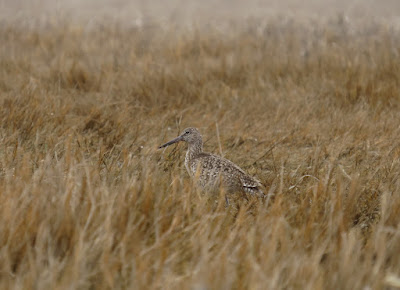I put in under the highway bridge for a low tide trip through the marsh. Bird migration is at peak these days along the east coast and the Wheeler is a particularly good place to see a variety of birds as they come to stay, or come to feed before continuing north. It is already 75F by mid-morning and when I put in, the tide is a 1/2 hour past low and there is a light breeze coming upriver. I thought it might feel hot, but the 50F water is keeping it pretty comfortable.
Right away, when I get to the top of the marsh, I start hearing and seeing Willets. When I was here four days ago, I didn't sight any. There are quite a few as I head down Nell's channel, although I can't see many of them. With the low tide, I am four feet below the top of the banks. One of the reasons to come here at low tide is because some of the shore birds will be feeding on the exposed silt shoreline.
I have been collecting old bottles from the cut banks in this marsh as a method of determining a rate of build up of the marsh soil. I've, so far, figured that it takes about 50 years for 1 foot of soil to build up. While I am paddling along the exposed bank, I reflect on the idea that my location is about 200 years ago.
Near the bottom of Nell's channel, just before it bends right into the main river, I spot a brown glass screw top beer bottle in the bank. It is 8 inches below the surface, and I carefully collect it. This is Wheeler Specimen 8. |
| Specimen 8 in situ |
I take the inner exit for Nell's channel. At some low tides, this channel runs out of water, but today I have 8 inches to a foot of water. This route takes me right to Milford Point, where I find a good 200 Brants. Brants winter here, although not in these numbers. They are migrating north. I let the wind drift me past them, and only stir a couple dozen, and they only fly a hundred yards. Quite a bit different than how Canada Geese would respond. I find three Oystercatchers near the halfway point as I head over to the east edge.
 |
| Oystercatcher |
I spot a small duck decoy up against a mound of spartina. When the canoe is about 3 feet from the decoy, it flushes, but settle down about 20 feet away. Surprise me, or what. It's not readily familiar to me so I have to look it up when I get home. (it is a male Ruddy Duck in winter colors. It is not migrating north, but west instead. They winter here, but we are at the northern wintering limit and I have only seen a few)
 |
| Ruddy Duck - male in winter colors |
On the east side of the marsh, I find a large number of Yellow Legs. I've been seeing them in ones and twos most of the way through the marsh, but over here, they are constant sight.
 |
| Brants |
 |
| Specimen 9 |
I head out and upriver, spotting a small flock of ten Least Sandpipers just before leaving the marsh.





































